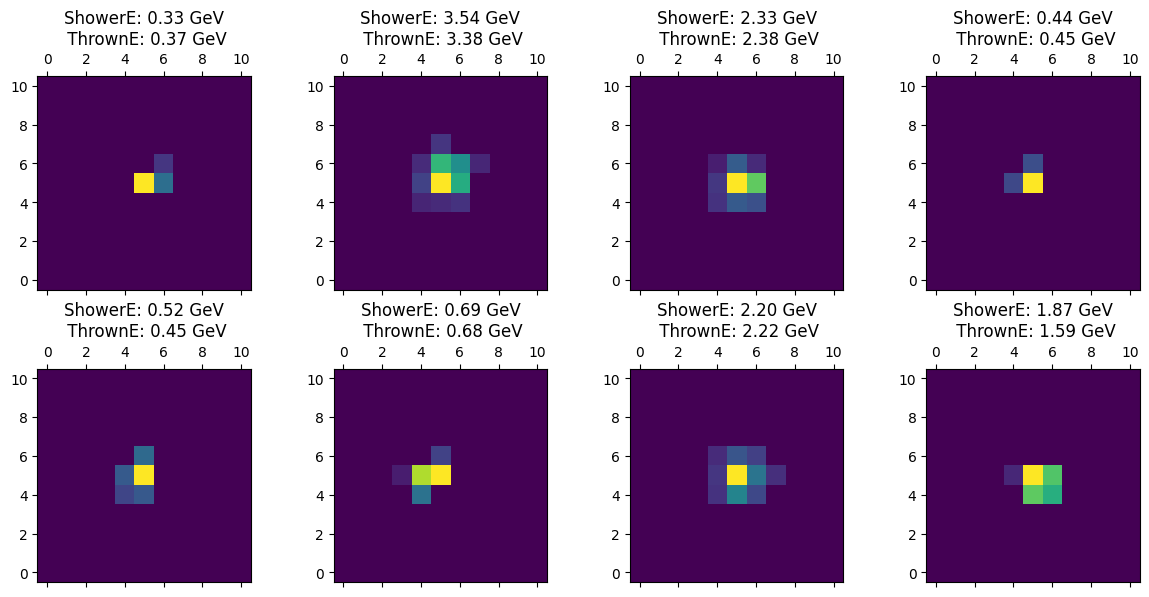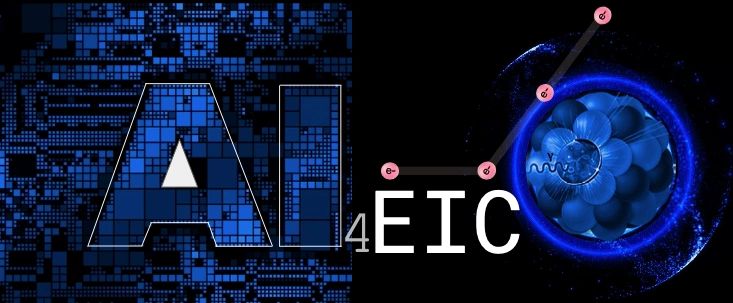Problem Formulation#
The Forward Calorimeter (FCAL) in the GlueX detector is a high-granularity electromagnetic calorimeter composed of lead-glass modules arranged in a square grid. It measures the position and energy of electromagnetic (EM) showers produced by incident photons and electrons. When a high-energy photon enters the FCAL, it converts into an \(e^+e^-\) pair, initiating a cascade of secondary particles that deposit energy across neighboring calorimeter cells. The resulting two-dimensional energy map — the hit pattern — reflects the spatial development of the shower.
In this study, we focus exclusively on photon-induced showers simulated with the GlueX Monte Carlo (HDGeant4 + halld_recon). From these reconstructed showers, we extract localized patches of the FCAL energy map centered around the shower maximum. Each patch encodes a localized shower image in the \((\text{row}, \text{col})\) grid, normalized to the total deposited energy.
Problem Definition#
The goal of this exercise is to develop a Generative Adversarial Network (GAN) that can synthesize realistic FCAL shower images, conditioned on the thrown photon energy (\(E_{\text{thrown}}\)).
Formally, the generative model learns a conditional mapping:
where:
\(z\) is a random latent vector,
\(E_{\text{thrown}}\) is the conditioning variable (photon energy),
\(\hat{I}_{\text{shower}}\) is the generated shower image (energy pattern).
The discriminator is trained to distinguish real shower patches (from simulation) from fake ones (produced by the generator), also conditioned on \(E_{\text{thrown}}\).
This conditional GAN (cGAN) framework enables the model to learn how the shape and spread of the shower evolve with photon energy — for instance, higher-energy photons producing deeper and broader cascades.
Dataset and Preprocessing#
The dataset is built from reconstructed photon showers only. We will use the same dataset used for classification and regression:
Event Selection
Only neutral showers with true particle ID = γ are included.
Showers must be within the FCAL fiducial region to avoid edge effects.
Patch Extraction
For each shower, an \(N \times N\) patch (e.g., \(11 \times 11\)) centered on the cell with maximum deposited energy is extracted.
The patch represents the local spatial distribution of deposited energy.
Normalization
Energy values are normalized using a log-scaling transformation to compress the dynamic range: $\( E' = \frac{\log(1 + E / E_0)}{\log(1 + E_{\text{max}} / E_0)} \)$
This ensures numerical stability and highlights relative shower shapes rather than absolute scales.
Condition Variable
The thrown photon energy (\(E_{\text{thrown}}\)) is recorded for each patch and normalized to [0, 1].
This is used as the conditioning input to both generator and discriminator.
The dataset can be found in huggingface.

Fig. 5 :caption: A sample training dataset to generate FCAL shower energy patches is shown below. The pixel energies and thrownE are normalized as mentioned above.#
Data preprocessing#
For this demonstration, the dataset is restricted to events with thrown photon energies between 1.0 GeV and 2.0 GeV.
This limited range serves two purposes:
Computational Feasibility:
Restricting to a narrow energy window ensures that the GAN can be trained efficiently — even on CPU — within a reasonable number of epochs.
It also reduces the overall dynamic range of shower intensities, simplifying the conditional learning task.Controlled Conditioning:
By fixing a limited energy range, the model focuses on learning fine-grained variations in shower shape rather than global scaling with energy.
This allows clearer interpretation of the conditioning effect and better visual inspection of generated patterns.
Hit Energy Threshold#
Because a GAN learns to generate physically plausible but not pixel-by-pixel identical hit patterns, a small energy threshold is applied to define realistic cell occupancies.
In particular, we apply a per-cell energy cut of 0.05 GeV (50 MeV) when evaluating or visualizing generated showers:
This threshold reflects the approximate detection sensitivity of the Forward Calorimeter and helps eliminate numerical noise or unphysical low-level fluctuations in the generated images.
By doing so, the comparison between real and generated showers focuses on meaningful energy deposits — i.e., those that would actually produce measurable detector responses — rather than on statistical pixel noise or reconstruction artifacts.
Practical Implication#
With these cuts:
The GAN trains faster and more stably due to reduced input variance.
Visual and quantitative metrics (e.g., occupancy, E1/E9) become more physically interpretable.
Generated showers correspond to realistic FCAL responses within the 1–2 GeV photon energy regime, making them ideal for illustrating the principles of conditional generative modeling in calorimeter simulation.
Note
Model trained on the full range with \(0.01 \leq \text{thrownE} \leq 4.0~[\text{GeV}]\) with a minimum Hit Energy threshold of \(0.01\)[GeV] can be found in generatorGAN-FCAL-100MeV-4GeV.safetensors

